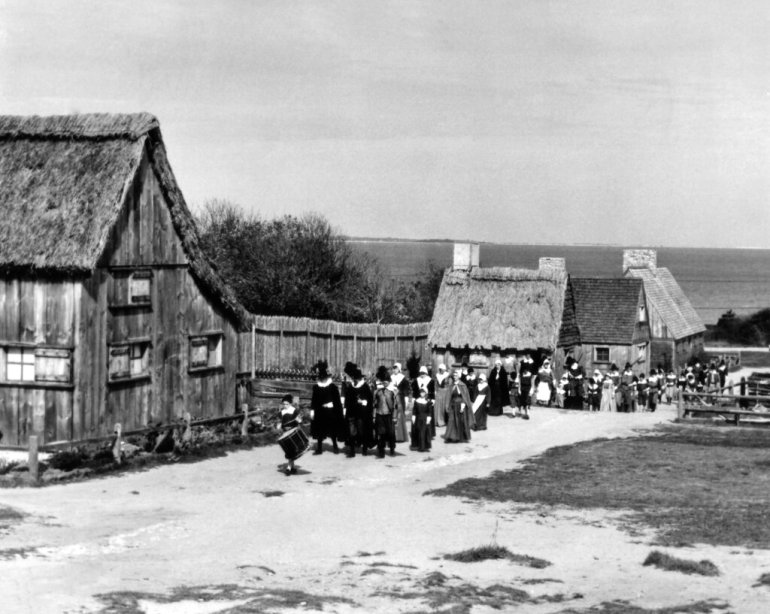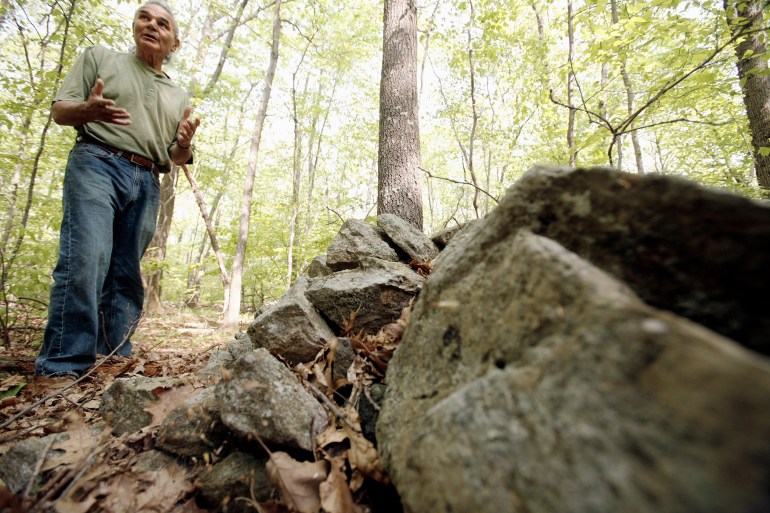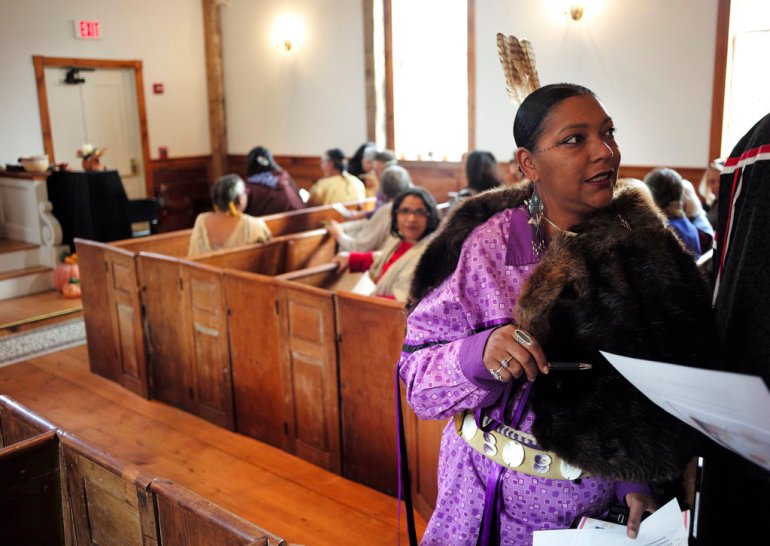Native Americans share long-ignored Thanksgiving truths
Wampanoag community is telling its Thanksgiving story as nationwide push to recognise Indigenous history in US grows.

Every year, on the fourth Thursday of November, the United States celebrates Thanksgiving.
The national holiday – one of the busiest travel periods in the US – is a time for families across the country to gather for a traditional meal of roasted turkey, squash, corn, mashed potatoes, and pumpkin pie.
Keep reading
list of 4 itemsSnatched away: The Indigenous women taken on the Highway of Tears
Residential Schools: Canada’s Indigenous Shame
Biden is first US president to mark Indigenous Peoples’ Day
In popular legend, the Thanksgiving feast can be traced back to a friendly gathering about 400 years ago between English Pilgrims – settlers who travelled on board the Mayflower ship – and Native Americans at Plymouth, in present-day Massachusetts.
But for the Indigenous people who had called the area home for at least 12,000 years, the arrival of the British settlers led to plague, genocide and intergenerational trauma that persists to this day.
“The narrative around Thanksgiving today ignores our history,” said Steven Peters, a member of the Mashpee tribe of the Wampanoag in Massachusetts, who regard Thanksgiving as a national day of mourning.
“It paints the picture of these helpful Indians that were waiting around for the Pilgrims to arrive so we could teach them how to hunt, fish, and grow crops successfully,” Peters told Al Jazeera, stressing, however, that this is not really what happened.
‘The Great Interruption’
Now, the Wampanoag are reclaiming the history of Thanksgiving amid a nationwide push across the US to recognise – and grapple with – the legacy of colonialism and its lasting effects on Indigenous people and communities.
When the first European explorers arrived in North America, the Wampanoag were a thriving federation of 70 villages home to as many as approximately 100,000 people.
The Wampanoag, whose name means “People of the First Light”, inhabited the western coast of Cape Cod Bay, fruitful lands populated by deer and elk in the forests, and fish and clams in the rivers. They cultivated corn, squash and beans. In the cold winters, they moved inland to warmer housing away from the harsh North Atlantic weather.

But sometime around 1616, Europeans arriving in the New World brought viruses that devastated the Indigenous population.
Villagers began showing signs of illness, a yellowing of the skin, fever and blisters, Peters said. The unknown plague ripped through the Wampanoag nation. Once sick, most died within a few days. An estimated 80 percent to 90 percent of the population was wiped out within three years.
The Wampanoag call it, “the Great Interruption”.
The Mayflower
A few years before the Mayflower arrived in 1620, a group of English explorers had kidnapped about 20 Wampanoag men, who were then sold as slaves in Spain, said Peters, who today is a keeper of the Wampanoag’s historical narrative.
Among them was a man named Tisquantum, who travelled from Spain to England and eventually returned home before the arrival of the Mayflower.
Tisquantum, also known by the name Squanto, found his village had been wiped out by the plague. But having learned the English language, he served as an interpreter and guide for the early Pilgrims, who were religious separatists.
Historians know about the first Thanksgiving because of a letter written by Edward Winslow, one of the Pilgrim leaders.
“Our harvest being gotten in, our Governor sent four men on fowling, that so we might after a more special manner rejoice together, after we had gather the fruit of labours,” Winslow wrote.
A group of some 90 Wampanoag men, who Peters said were probably warriors, joined with the Pilgrims in feast and entertainment for three days, Winslow wrote. The feast lifted the spectre of starvation from the colonists.

Little else is known about that encounter, but history provides some context.
For 50 years, the colonists and the Wampanoag co-existed in an alliance under the leadership of Wampanoag chieftain Massasoit.
But when Massasoit died, his younger son became chief and abandoned the peace agreement following violations by the colonists in a history detailed in the 2019 book titled, This Land Is Their Land, by David J Silverman.
‘Brink of extinction’
A devastating war followed from 1675 to 1678 between the Wampanoag and the colonists. Hundreds were killed on both sides and when the conflict was over, the Wampanoag were defeated. Many were executed or sold into slavery.
“Our language was taken away from us. Our kids were put into boarding school. Families were ripped apart. Eventually, we lost our land to taxes. So we were left with nothing,” Peters told Al Jazeera.
“There was a point in time where we were down to probably 1,000 or less people. We were on the brink of extinction,” Peters said.

For more than two centuries, the legend of Thanksgiving was observed by colonists in the US as a harvest festival until President Abraham Lincoln declared it a national day of prayer and thanksgiving to God in 1863, during the US Civil War.
Some historians think the first official English Thanksgiving feast may have happened in Virginia circa 1619, when a group of colonists were directed to hold an annual ceremony giving thanks for their arrival in the New World.
But the English colonists and Virginia tribes of the Powhatan Nation fought a series of wars. Over time, the colonists pushed the Native Americans onto reservations or westward towards the Appalachian mountains.
The Wampanoag people today number about 10,000, Peters said – and the community is growing.
Community leaders are working on developing affordable housing, jobs, and education, while efforts to revive the Wampanoag language are under way, including by using a text of the Bible that was translated 350 years ago.
The Wampanoag language had largely died out by the mid-1800s as the number of native speakers dwindled.
The Mashpee tribe also has built a museum, in Mashpee, Massachusetts with exhibits and videos telling the community’s side of the Thanksgiving story.
“We’re trying to build something back that was taken away from us,” Peters said.
“Through education such as the exhibits that we do, videos, artists’ renditions, we can start to break down some of the stereotypes and the systemic racism that continues to persist today in our society.”
The history of other groups of Indigenous Americans are also being included in narratives that once only told the European side of the story in the United States.
In an historical district of Williamsburg, Virginia, once the capital of the English colony, re-enactors are sharing history and knowledge of Virginia’s Native tribes at a living history encampment.
The Pamunkey, Mattaponi and Chickahominy tribes were a regular presence in 18th-century Williamsburg and other Virginia settlements.
“The story of America is incomplete without understanding the Indigenous populations and the impact they had on the building of our nation,” Colonial Williamsburg President Cliff Fleet said in a letter celebrating American Indian heritage month, in November.

Like those in Massachusetts, Indigenous communities in Virginia are gaining greater, if belated, recognition of their tribal rights in nation-to-nation dealings with the state. For instance, in his final order before leaving office in January, Virginia Governor Ralph Northam required state agencies to consult with tribes before making decisions that affect important Indigenous lands and waters.
Earlier this year, President Joe Biden became the first US president to recognise Indigenous Peoples’ Day on the same day as Columbus Day, a holiday that commemorates the Italian navigator Christopher Columbus, which Native Americans have long protested.
Several statues of Columbus have been removed from US cities in recent years amid a reckoning with the lasting legacy of colonialism.
Indicative of the shift in the US, Biden appointed Deb Haaland, a Native American from Arizona and former member of Congress, to serve as secretary of the interior, the US department that governs Indigenous affairs.
Most recently, Biden hosted a summit of 570 tribal leaders from across the US at the White House on November 15. The White House unveiled billions in new infrastructure, social and public safety programmes for US tribes, including better recognition of their historic treaty rights.